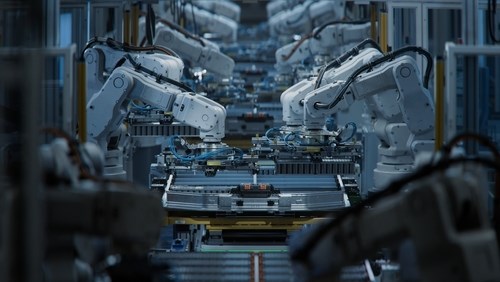
SCANOLOGY has just introduced NimbleTrack Gen2. With upgraded technology, SCANOLOGY's NimbleTrack Gen2 is capable of scanning large and complex areas significantly faster, while maintaining measurement-level accuracy. This is the next generation of the company's mobile optical tracking and 3D scanning systems. SCANOLOGY's NimbleTrack Gen2 is designed to deliver higher performance, especially in speed and measurement range.

A breakthrough opportunity for R&D processes awaits the Vietnamese engineering community. The specialized workshop "Driving Engineering Innovation Through Smart Simulation" organized by ANSYS will take place on October 29, 2025, at the Innovation Hub Building, updating the latest advanced simulation solutions for the manufacturing, electronics design, and Nano-Micro industries.

In the global race to automate manufacturing, China is emerging as a pioneer with the “dark factory” model – where robots and artificial intelligence completely replace humans. Requiring no light or rest, the new generation of factories operate continuously 24/7 with superior precision and efficiency.
China dominates with its ability to produce humanoid robots at a large scale, low cost, and quickly train and deploy them for practical use.
Humanoid robots are AI-equipped machines designed to resemble humans in both appearance and movement. According to CNBC, American technology companies are accelerating the development of humanoid robots, highlighting their importance to the future economy. However, analysts warn they are at risk of losing to Chinese competitors.

The Tiangong Ultra robot finished first in the robot category at a Beijing half-marathon on April 19, with a time of 2 hours and 40 minutes. Photo: Fred Dufour/NBC News
Thomas Andersson, founder of the UK research firm STIQ, believes that Chinese companies could dominate the market. "The supply chain and the entire ecosystem for robots in China are enormous, and the development and R&D processes are straightforward," he told the BBC.
Chinese companies benefit greatly from government support. According to Global Times, in early 2024, seven Chinese ministries, including the Ministry of Industry and Information Technology and the Ministry of Science and Technology, announced new guidelines to achieve breakthroughs in various fields such as humanoid robots, quantum computing, high-speed trains, and 6G devices. This not only creates a favorable legal environment but also accelerates robot development.
Some cities, like Beijing and Shenzhen, have also established high-tech zones, attracting numerous businesses and research institutions. For example, the Beijing Economic-Technological Development Area currently hosts 110 robotics companies, forming a comprehensive industrial chain.
Shanghai has even built a comprehensive humanoid robot training facility spanning over 5,000 square meters with specialized training scenarios like welding, 3C product manufacturing (computers, telecommunications, consumer electronics), and automotive testing. In its initial phase, the facility can train more than 100 humanoid robots simultaneously and is expected to increase to 1,000 robots by 2027.
In a February report, the US bank Morgan Stanley estimated that the cost of manufacturing a humanoid robot currently ranges from $10,000 to $300,000, depending on configuration and application requirements. However, according to Reyk Knuhtsen, an analyst at the independent US research and analysis firm SemiAnalysis, Chinese companies are producing robots at a lower cost than their American counterparts due to economies of scale and superior manufacturing capabilities.
For example, the Chinese company Unitree launched its G1 model earlier this year with a starting price of $16,000. The robot is 130 cm tall, can walk at a speed of 7 km/h, and carry a 3 kg load in its hands for up to two hours. In contrast, Morgan Stanley estimates the cost of Tesla's 180 cm tall Optimus humanoid robot to be around $20,000. However, Tesla will only achieve this price point if it can scale up production, shorten the R&D cycle, and use low-cost components from China.
Tesla's Optimus appeared before a crowd in late 2024. Video: Tesla
Humanoid robots are composed of thousands of parts, including the "brain," which consists of semiconductors, generative AI models, and vision software—an area where the US has an advantage. According to Morgan Stanley's analysis, 13 out of 22 companies researching robot brains are based in the US, such as Meta, Microsoft, Nvidia, and Palantir, while only two are in China.
However, the bank estimates that only 4% of a humanoid robot's production cost is for the brain, with the majority spent on manufacturing the body, which includes numerous actuators, pistons, and skeletal frames. Of the 64 companies that produce body parts for robots, China has 21 and the US has 17. Furthermore, 56% of companies in the global humanoid robot supply chain are based in China.
Notably, China dominates the market for a type of advanced and expensive ball screw called a planetary roller screw, which is essential for most advanced robots today. Tariffs imposed by US President Donald Trump on the country could potentially drive up the cost of materials for many robot manufacturers.
According to the Carnegie Endowment for International Peace research organization in Washington, China also leads the battery industry, holding a 70-90% global market share at every stage of the lithium-ion battery value chain. The country also dominates the rare-earth market, which is critical for manufacturing robots. On April 22, Tesla CEO Elon Musk stated that Optimus production was being disrupted by China's export restrictions on rare-earth magnets, which were imposed in retaliation for US tariffs.
China has demonstrated the ability to apply humanoid robots in various fields. A recent example is the first half-marathon competition for both athletes and humanoid robots held in Beijing on April 19.
Tiangong Ultra, developed by the Beijing Humanoid Robot Innovation Center, finished first in the robot category with a time of 2 hours and 40 minutes for the 21.0975 km distance. In contrast, the top athlete finished in 1 hour and 2 minutes. Although the robot was slower than a human, the competition showed a significant step forward in developing robot mobility and interaction capabilities.
In January, Unitree had 16 of its H1 robots perform a dance with a group of dancers to celebrate the Lunar New Year in a televised performance on Chinese national television. The robots impressed viewers with their precise mechanical arm movements, which could spin and toss handkerchiefs gracefully.
Unitree's H1 robots perform at China's Year of the Snake New Year gala. Video: CGTN
UBTech's Walker S1 model is currently working at the Audi-FAW new energy vehicle factory in China. In addition to Audi, other major manufacturers like BYD, Zeekr, Geely, and Foxconn also use the Walker S series, and over 500 robots have been pre-ordered. At BYD's factory in Shenzhen, the Walker S1 has helped increase sorting efficiency by 120%.
In the past five years, China has topped the world in the number of patent applications related to humanoid robots, with 5,590 compared to the US's 1,442, according to Morgan Stanley's analysis. The International Federation of Robotics states that China has deployed more industrial robots in factories than all other countries combined since 2021. In 2024, Chinese companies introduced 35 humanoid robots to the market, accounting for two-thirds of the global total. Companies in the US and Canada launched a total of 8 robots.
According to a SemiAnalysis report in early April, Unitree's G1 uses no American components at all. The report also suggests that China is the only country that can reap the economic benefits from intelligent robotic systems, including humanoid robots, "posing a threat to the US as it is defeated on all fronts."
"To catch up, American companies need to quickly establish a strong manufacturing and industrial base, either domestically or through allies. For Tesla and similar companies, it might be wise to start bringing manufacturing and component supply back to the US or allied countries to reduce dependency on China," Knuhtsen noted.
The humanoid robot industry is still very new, but the landscape of the race is becoming clear. "If the US, Europe, Japan, and South Korea don't take serious and strong action soon, it will be very difficult to compete with China in the long run," William Matthews, an expert at the UK research organization Chatham House, told Business Insider. He believes China is winning the humanoid robot race.
(84) 896 555 247